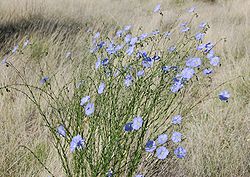| Linum lewisii | |
|---|---|
 | |
| In Elena Gallegos Picnic Area, Albuquerque, NM | |
| Scientific classification | |
| Kingdom: | Plantae |
| Clade: | Tracheophytes |
| Clade: | Angiosperms |
| Clade: | Eudicots |
| Clade: | Rosids |
| Order: | Malpighiales |
| Family: | Linaceae |
| Genus: | Linum |
| Species: | L. lewisii |
| Binomial name | |
| Linum lewisii | |
| Varieties | |
| |
| Synonyms [2] | |
List
| |
Linum lewisii (Linum perenne var. lewisii) (Lewis flax, blue flax or prairie flax) is a perennial plant in the family Linaceae, native to western North America.



